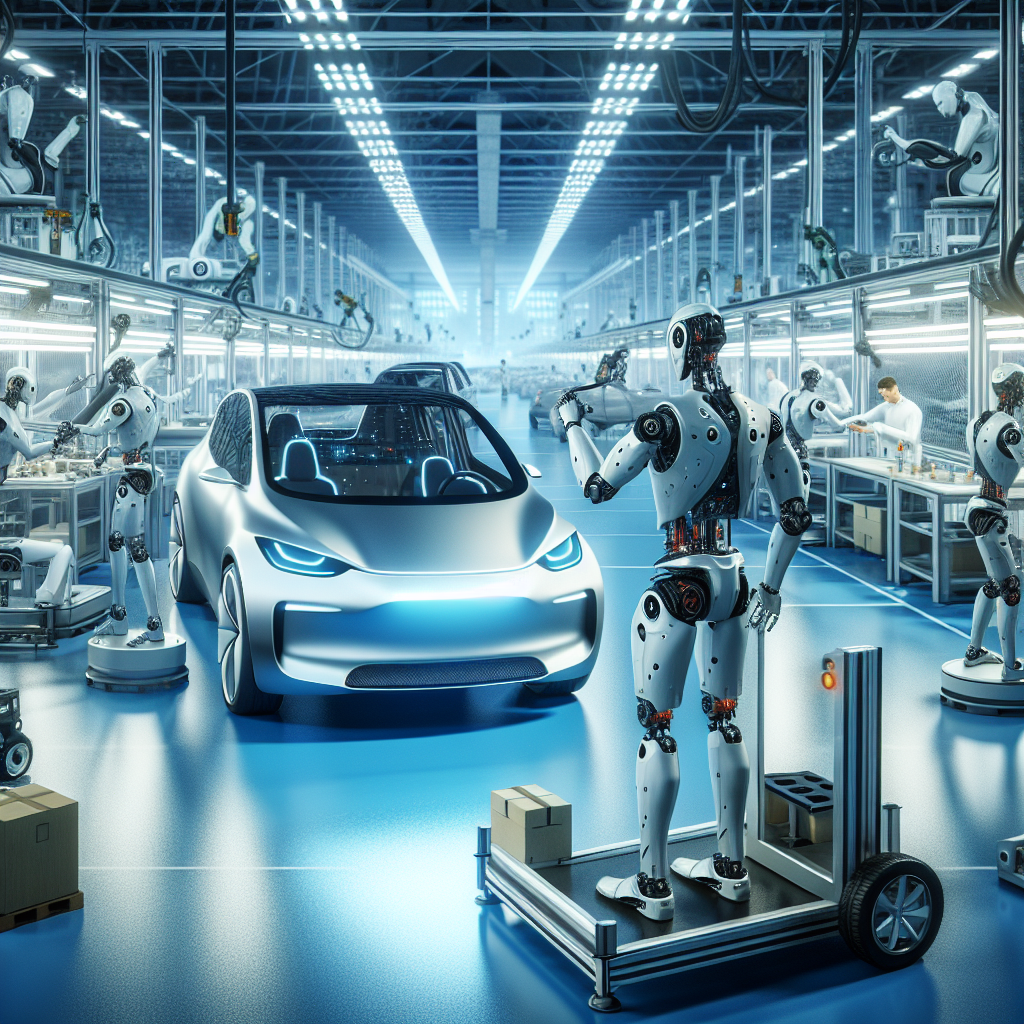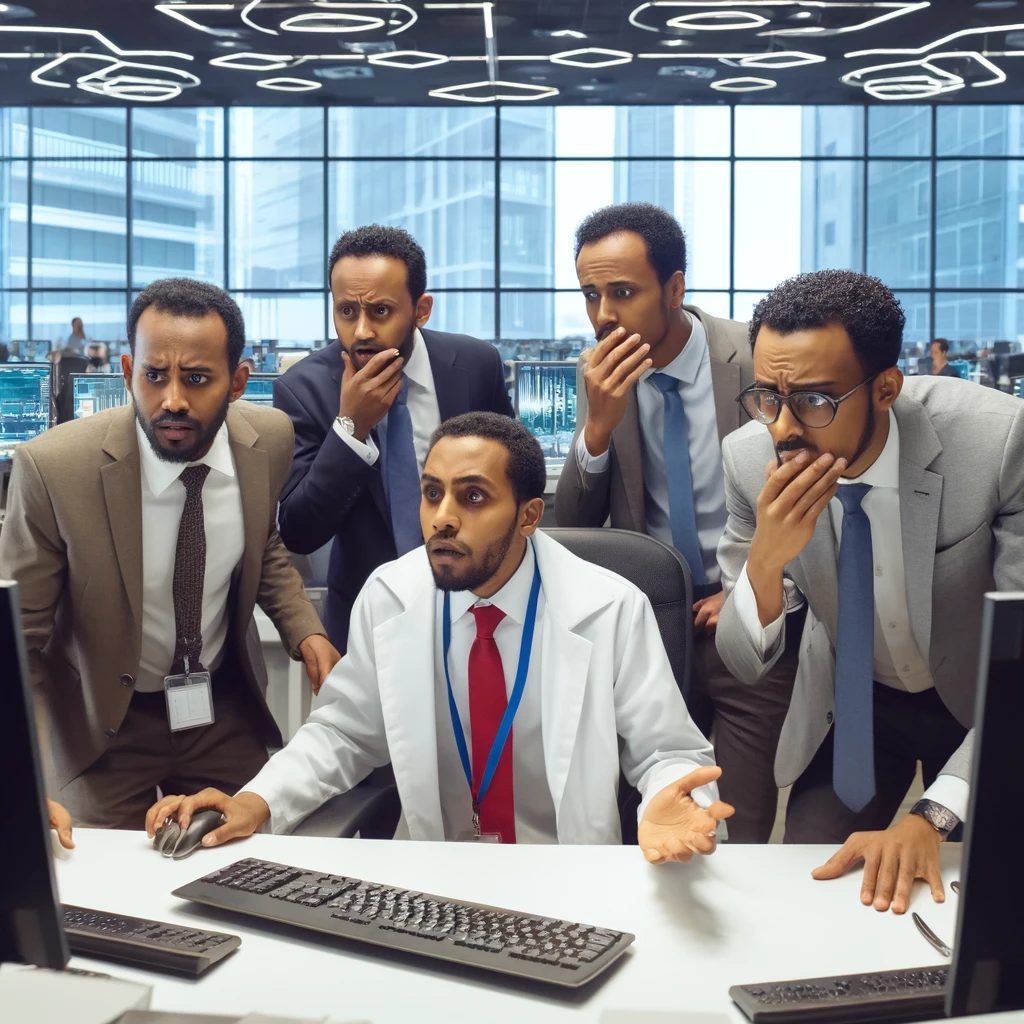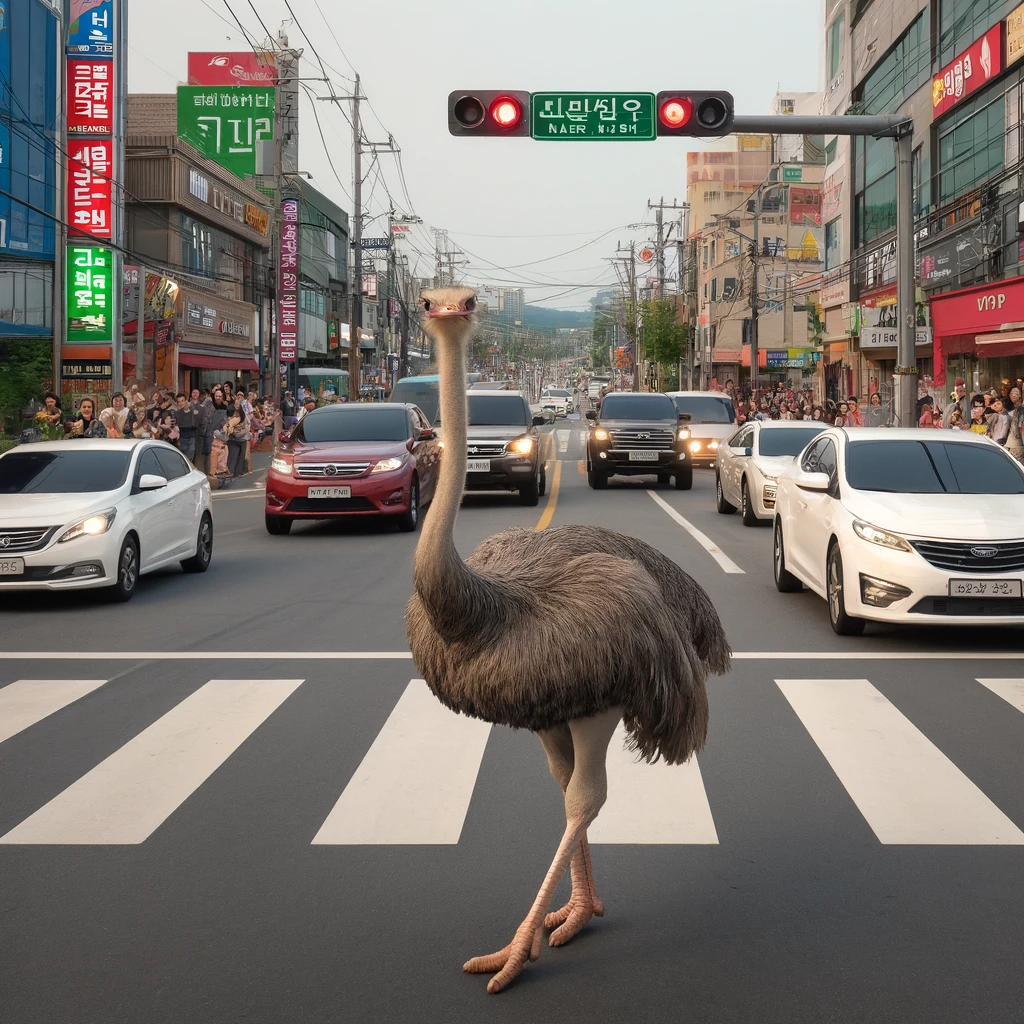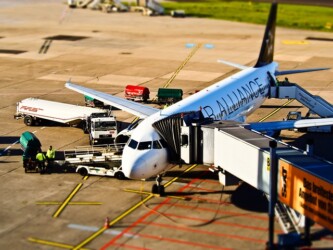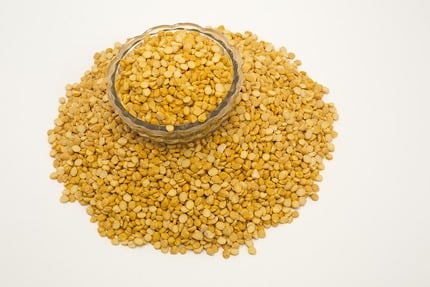Elon Musk, the CEO of Tesla, has announced that the company plans to begin utilizing humanoid robots in its factories as early as next year. In a recent social media update, Musk revealed that Tesla will not only start using these robots internally but will also begin production for commercial sale by 2026. This move comes as Tesla faces challenges related to declining demand for its electric vehicles, prompting the company to explore innovative solutions to reduce operational costs.
The announcement of humanoid robots follows a significant drop in Tesla’s profits, which fell nearly 50% in the second quarter of the year. The company’s profits decreased from $2.7 billion to less than $1.5 billion, largely due to a slump in sales. Despite implementing price cuts and incentives to attract customers, Tesla reported a 7% year-on-year decline in automotive revenue. However, the company did manage to achieve a slight overall revenue increase of 2%, thanks to growth in its energy storage sector.
Musk’s focus on robotics and artificial intelligence comes at a time when the demand for electric vehicles is slowing down. He has previously expressed confidence that the humanoid robot, named Optimus, would be ready for deployment in Tesla factories by the end of this year. In his latest statement, he reiterated that Tesla aims to have low production of these robots for internal use in 2024, with hopes for higher production levels for external clients by 2026.
Tesla’s vision for the Optimus robot is to create an “autonomous humanoid robot” capable of performing tasks that are deemed unsafe, repetitive, or tedious. Musk has set an ambitious goal for the robots to be mass-produced at a cost of less than $20,000 each. However, he is known for making bold predictions regarding timelines, which have not always been met. For instance, he previously anticipated the rollout of self-driving taxis by 2020, a timeline that has since been pushed back.
In addition to Tesla, other companies such as Honda and Boston Dynamics are also working on developing their own humanoid robots. As Tesla continues to innovate in the fields of artificial intelligence and robotics, the company’s future endeavors will depend on both technological advancements and regulatory approvals. Musk has indicated that Tesla is still actively pursuing the development of robo-taxis, although the timeline for their introduction remains uncertain.
Original news source: Musk says Tesla to use humanoid robots next year (BBC)
🎧 Listen:
Slow
Normal
Fast
📖 Vocabulary:
| 1 | humanoid | Resembling a human in appearance or behavior |
| 2 | operational | Related to the functioning or management of a business or organization |
| 3 | slump | A significant decline or decrease in activity or performance |
| 4 | incentives | Rewards or benefits offered to encourage specific actions or behaviors |
| 5 | deployment | The act of moving something into position for use or action |
| 6 | autonomous | Capable of operating independently without human control |
| 7 | tedious | Boring, monotonous, and repetitive |
| 8 | mass-produced | Manufactured in large quantities, typically using machinery |
| 9 | anticipated | Expected or predicted to happen in the future |
| 10 | rollout | The introduction or launch of a new product or service |
| 11 | endeavors | Efforts or attempts to achieve a goal or complete a task |
| 12 | advancements | Progress or improvements in technology or knowledge |
| 13 | regulatory | Related to rules or laws governing an activity or process |
| 14 | pursuing | Actively working towards achieving a goal or objective |
| 15 | uncertain | Not clearly known or decided, lacking certainty or predictability |
Group or Classroom Activities
Warm-up Activities:
– CHARADES
Instructions: Divide the class into small groups. Each group will take turns acting out key concepts or terms from the article (e.g., “humanoid robot,” “autonomous,” “artificial intelligence”). The rest of the class will guess what they are acting out. This activity helps reinforce vocabulary and encourages creative thinking.
– OPINION POLL
Instructions: Students will read the article and then express their opinions on the use of humanoid robots in factories. Create a set of statements (e.g., “Humanoid robots will improve workplace safety”) for students to agree or disagree with. Students will walk around the classroom, asking their peers for their opinions and tallying the responses.
– MIND MAP
Instructions: In small groups, students will create a mind map based on the article. They should start with “Tesla’s Humanoid Robots” in the center and branch out to include related ideas such as “challenges,” “benefits,” “timeline,” and “other companies.” This visual organization helps students synthesize information and understand the connections between concepts.
– SYNONYM CHALLENGE
Instructions: Provide students with a list of key vocabulary from the article. Students will work in pairs to come up with synonyms for each word. Afterward, they will share their synonyms with the class, and the teacher will facilitate a discussion on the nuances of the words and their context in the article.
– FUTURE PREDICTIONS
Instructions: After reading the article, students will engage in a discussion about the future of humanoid robots in the workforce. They will make predictions about how these robots might impact jobs, industry standards, and daily life in the next 5-10 years. Each student will share their predictions, and the class can discuss the feasibility and implications of these ideas.
🤔 Comprehension Questions:
1. What plans did Elon Musk announce regarding the use of humanoid robots at Tesla factories?
2. How did Tesla’s profits change in the second quarter of the year, and what was a major factor contributing to this change?
3. What specific challenges is Tesla facing that prompted the exploration of humanoid robots?
4. What is the expected timeline for the production and deployment of the Optimus robot in Tesla factories?
5. What are the intended functions of the Optimus robot, and what is the target production cost for each unit?
6. How does Tesla’s revenue from its energy storage sector compare to its automotive revenue in the recent report?
7. Which other companies are mentioned as being involved in the development of humanoid robots alongside Tesla?
8. What factors will influence Tesla’s future endeavors in robotics and artificial intelligence, according to the article?
Go to answers ⇩
🎧✍️ Listen and Fill in the Gaps:
Elon Musk, the CEO of (1)______, has announced that the company plans to begin utilizing humanoid robots in its factories as early as next year. In a recent social media update, Musk revealed that Tesla will not only start using these robots internally but will also begin production for commercial sale by 2026. This move (2)______ as Tesla faces challenges related to declining (3)______ for its electric vehicles, prompting the company to explore innovative solutions to reduce operational costs.
The announcement of humanoid robots follows a significant drop in Tesla’s profits, which fell nearly 50% in the (4)______ quarter of the year. The (5)______’s profits decreased from $2.7 billion to less than $1.5 billion, largely due to a slump in sales. Despite (6)______ price cuts and incentives to attract customers, Tesla (7)______ a 7% year-on-year decline in automotive revenue. However, the company did manage to achieve a slight (8)______ revenue increase of 2%, thanks to growth in its energy storage sector.
Musk’s focus on robotics and artificial intelligence comes at a time when the demand for electric vehicles is slowing down. He has previously expressed confidence that the humanoid robot, named Optimus, would be ready for (9)______ in Tesla factories by the end of this year. In his latest (10)______, he reiterated that Tesla aims to have low production of these (11)______s for internal use in 2024, with hopes for higher production levels for external clients by 2026.
Tesla’s vision for the Optimus robot is to (12)______ an “autonomous humanoid robot” capable of performing tasks that are deemed unsafe, repetitive, or tedious. Musk has set an ambitious goal for the robots to be mass-produced at a cost of less than $20,000 each. However, he is known for making bold predictions regarding timelines, which have not always been met. For instance, he previously anticipated the (13)______ of self-driving taxis by 2020, a timeline that has since been pushed back.
In (14)______ to Tesla, (15)______ companies such as Honda and Boston Dynamics are also working on developing their own humanoid (16)______. As Tesla continues to innovate in the fields of artificial intelligence and robotics, the company’s future endeavors will depend on both technological advancements and regulatory approvals. Musk has indicated that Tesla is still actively pursuing the development of robo-taxis, although the timeline for their introduction remains uncertain.
Go to answers ⇩
💬 Discussion Questions:
Students can ask a partner these questions, or discuss them as a group.
1. What is your opinion on the use of humanoid robots in factories? Do you think it is a positive development? Why or why not?
2. How would you feel if a humanoid robot were to take over your job? Would you be concerned or excited about the change?
3. Do you like the idea of having robots assist in everyday tasks? Why or why not?
4. What is a potential benefit of using humanoid robots in industries like automotive manufacturing?
5. How do you think the introduction of humanoid robots will impact the job market in the future?
6. Do you think companies should prioritize the development of humanoid robots over hiring human workers? Why or why not?
7. What is a concern you have about the increasing use of artificial intelligence and robotics in our lives?
8. How would you feel if you had to interact with a humanoid robot on a daily basis? Would you find it comfortable or unsettling?
9. Do you think Elon Musk’s ambitious timelines for technology development are realistic? Why or why not?
10. What is a task you believe would be better suited for a robot than a human? Why?
11. How do you think society should address the ethical implications of using humanoid robots in the workforce?
12. Do you think the production of humanoid robots will lead to a decrease in human creativity and innovation? Why or why not?
13. What is a potential drawback of relying too heavily on robots in industries?
14. How would you feel if robots became commonplace in your home, assisting with chores and daily tasks? Would you welcome that or prefer to do things yourself?
15. Do you believe that advancements in robotics will ultimately improve or hinder our quality of life? Why?
Individual Activities
📖💭 Vocabulary Meanings:
Match each word to its meaning.
Words:
1. humanoid
2. operational
3. slump
4. incentives
5. deployment
6. autonomous
7. tedious
8. mass-produced
9. anticipated
10. rollout
11. endeavors
12. advancements
13. regulatory
14. pursuing
15. uncertain
Meanings:
(A) Not clearly known or decided, lacking certainty or predictability
(B) Efforts or attempts to achieve a goal or complete a task
(C) A significant decline or decrease in activity or performance
(D) Actively working towards achieving a goal or objective
(E) Boring, monotonous, and repetitive
(F) Expected or predicted to happen in the future
(G) Related to the functioning or management of a business or organization
(H) Manufactured in large quantities, typically using machinery
(I) Related to rules or laws governing an activity or process
(J) Capable of operating independently without human control
(K) Rewards or benefits offered to encourage specific actions or behaviors
(L) Progress or improvements in technology or knowledge
(M) The act of moving something into position for use or action
(N) The introduction or launch of a new product or service
(O) Resembling a human in appearance or behavior
Go to answers ⇩
🔡 Multiple Choice Questions:
1. What is the name of the humanoid robot being developed by Tesla?
(a) Optimus
(b) Atlas
(c) Sophia
(d) Pepper
2. When does Tesla plan to start utilizing humanoid robots in its factories?
(a) This year
(b) Next year
(c) In 2025
(d) In 2026
3. By what year does Tesla aim to begin production of humanoid robots for commercial sale?
(a) 2025
(b) 2024
(c) 2023
(d) 2026
4. What was the percentage drop in Tesla’s profits in the second quarter of the year?
(a) 30%
(b) 20%
(c) Nearly 50%
(d) 10%
5. What is the target cost for mass-producing each Optimus robot?
(a) Less than $10,000
(b) Less than $30,000
(c) Less than $20,000
(d) Less than $50,000
6. Which sector contributed to a slight overall revenue increase for Tesla?
(a) Automotive sales
(b) Robotics
(c) Solar energy
(d) Energy storage
7. What type of tasks is the Optimus robot designed to perform?
(a) Creative and innovative tasks
(b) Unsafe, repetitive, or tedious tasks
(c) High-level decision-making tasks
(d) Customer service tasks
8. Which other companies are mentioned as working on humanoid robots?
(a) Honda and Boston Dynamics
(b) Ford and General Motors
(c) Apple and Microsoft
(d) Google and Amazon
Go to answers ⇩
🕵️ True or False Questions:
1. Tesla intends to begin production of humanoid robots for commercial sale by 2026.
2. The humanoid robot being developed by Tesla is named Optimus and is expected to be ready for deployment in factories by the end of this year.
3. Musk aims to mass-produce the Optimus robot at a cost of more than $20,000 each, although he has a history of making conservative predictions that may be met.
4. Elon Musk is not the CEO of Tesla and has announced plans to use robotic dogs in the company’s factories starting next year.
5. Other companies, including Honda and Boston Dynamics, are also engaged in the development of humanoid robots, while Tesla continues to explore advancements in artificial intelligence and robotics.
6. The announcement comes in response to increasing demand for Tesla’s electric vehicles and a significant rise in profits.
7. Despite a decline in automotive revenue, Tesla experienced a significant overall revenue decrease of 2% due to decline in its energy storage sector.
8. Tesla’s profits fell nearly 50% in the second quarter, decreasing from $2.7 billion to less than $1.5 billion.
Go to answers ⇩
📝 Write a Summary:
Write a summary of this news article in two sentences.
Check your writing now with the best free AI for English writing!
Writing Questions:
Answer the following questions. Write as much as you can for each answer.
Check your answers with our free English writing assistant!
1. What specific challenges is Tesla facing that prompted the decision to utilize humanoid robots in its factories?
2. How does Elon Musk envision the role of the Optimus robot in Tesla’s operations?
3. What are the projected timelines for the production and deployment of humanoid robots at Tesla?
4. How has Tesla’s financial performance influenced its strategy to incorporate robotics and artificial intelligence?
5. In what ways are Tesla’s competitors also engaging in the development of humanoid robots, and how might this impact Tesla’s market position?
✅ Answers
🤔✅ Comprehension Question Answers:
1. What plans did Elon Musk announce regarding the use of humanoid robots at Tesla factories?
Elon Musk announced that Tesla plans to begin utilizing humanoid robots in its factories as early as next year and will also start production for commercial sale by 2026.
2. How did Tesla’s profits change in the second quarter of the year, and what was a major factor contributing to this change?
Tesla’s profits fell nearly 50% in the second quarter of the year, decreasing from $2.7 billion to less than $1.5 billion, largely due to a slump in sales.
3. What specific challenges is Tesla facing that prompted the exploration of humanoid robots?
Tesla is facing declining demand for its electric vehicles, which has prompted the company to explore innovative solutions to reduce operational costs.
4. What is the expected timeline for the production and deployment of the Optimus robot in Tesla factories?
Tesla aims to have low production of the Optimus robot for internal use in 2024, with hopes for higher production levels for external clients by 2026.
5. What are the intended functions of the Optimus robot, and what is the target production cost for each unit?
The intended functions of the Optimus robot include performing tasks that are deemed unsafe, repetitive, or tedious, with a target production cost of less than $20,000 each.
6. How does Tesla’s revenue from its energy storage sector compare to its automotive revenue in the recent report?
Tesla reported a 7% year-on-year decline in automotive revenue, but managed to achieve a slight overall revenue increase of 2% thanks to growth in its energy storage sector.
7. Which other companies are mentioned as being involved in the development of humanoid robots alongside Tesla?
Other companies mentioned include Honda and Boston Dynamics, which are also working on developing their own humanoid robots.
8. What factors will influence Tesla’s future endeavors in robotics and artificial intelligence, according to the article?
Tesla’s future endeavors in robotics and artificial intelligence will depend on technological advancements and regulatory approvals.
Go back to questions ⇧
🎧✍️✅ Listen and Fill in the Gaps Answers:
(1) Tesla
(2) comes
(3) demand
(4) second
(5) company
(6) implementing
(7) reported
(8) overall
(9) deployment
(10) statement
(11) robot
(12) create
(13) rollout
(14) addition
(15) other
(16) robots
Go back to questions ⇧
📖💭✅ Vocabulary Meanings Answers:
1. humanoid
Answer: (O) Resembling a human in appearance or behavior
2. operational
Answer: (G) Related to the functioning or management of a business or organization
3. slump
Answer: (C) A significant decline or decrease in activity or performance
4. incentives
Answer: (K) Rewards or benefits offered to encourage specific actions or behaviors
5. deployment
Answer: (M) The act of moving something into position for use or action
6. autonomous
Answer: (J) Capable of operating independently without human control
7. tedious
Answer: (E) Boring, monotonous, and repetitive
8. mass-produced
Answer: (H) Manufactured in large quantities, typically using machinery
9. anticipated
Answer: (F) Expected or predicted to happen in the future
10. rollout
Answer: (N) The introduction or launch of a new product or service
11. endeavors
Answer: (B) Efforts or attempts to achieve a goal or complete a task
12. advancements
Answer: (L) Progress or improvements in technology or knowledge
13. regulatory
Answer: (I) Related to rules or laws governing an activity or process
14. pursuing
Answer: (D) Actively working towards achieving a goal or objective
15. uncertain
Answer: (A) Not clearly known or decided, lacking certainty or predictability
Go back to questions ⇧
🔡✅ Multiple Choice Answers:
1. What is the name of the humanoid robot being developed by Tesla?
Answer: (a) Optimus
2. When does Tesla plan to start utilizing humanoid robots in its factories?
Answer: (b) Next year
3. By what year does Tesla aim to begin production of humanoid robots for commercial sale?
Answer: (d) 2026
4. What was the percentage drop in Tesla’s profits in the second quarter of the year?
Answer: (c) Nearly 50%
5. What is the target cost for mass-producing each Optimus robot?
Answer: (c) Less than $20,000
6. Which sector contributed to a slight overall revenue increase for Tesla?
Answer: (d) Energy storage
7. What type of tasks is the Optimus robot designed to perform?
Answer: (b) Unsafe, repetitive, or tedious tasks
8. Which other companies are mentioned as working on humanoid robots?
Answer: (a) Honda and Boston Dynamics
Go back to questions ⇧
🕵️✅ True or False Answers:
1. Tesla intends to begin production of humanoid robots for commercial sale by 2026. (Answer: True)
2. The humanoid robot being developed by Tesla is named Optimus and is expected to be ready for deployment in factories by the end of this year. (Answer: True)
3. Musk aims to mass-produce the Optimus robot at a cost of more than $20,000 each, although he has a history of making conservative predictions that may be met. (Answer: False)
4. Elon Musk is not the CEO of Tesla and has announced plans to use robotic dogs in the company’s factories starting next year. (Answer: False)
5. Other companies, including Honda and Boston Dynamics, are also engaged in the development of humanoid robots, while Tesla continues to explore advancements in artificial intelligence and robotics. (Answer: True)
6. The announcement comes in response to increasing demand for Tesla’s electric vehicles and a significant rise in profits. (Answer: False)
7. Despite a decline in automotive revenue, Tesla experienced a significant overall revenue decrease of 2% due to decline in its energy storage sector. (Answer: False)
8. Tesla’s profits fell nearly 50% in the second quarter, decreasing from $2.7 billion to less than $1.5 billion. (Answer: True)
Go back to questions ⇧



